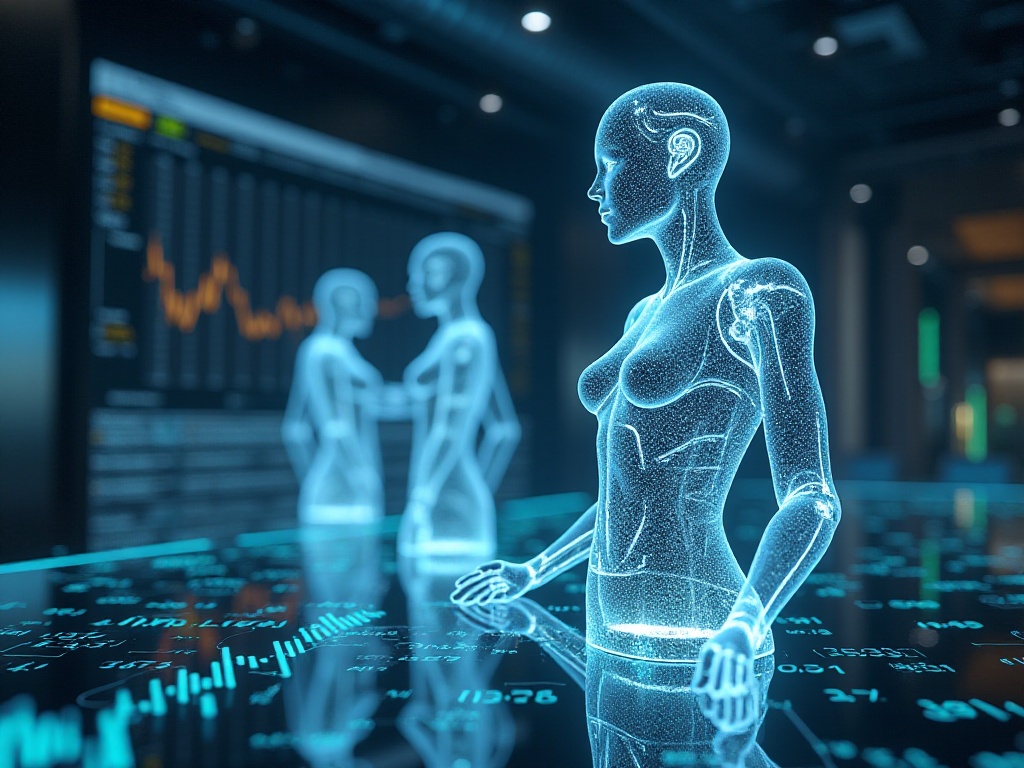Introduction
Recently, every time I call customer service, I find the experience particularly interesting because I can feel the presence of AI. Whether I'm consulting with banks about credit card issues, handling returns with e-commerce platforms, or contacting airlines to change flight tickets, the first step almost always involves talking to an AI assistant. This experience has made me wonder: to what extent will AI change the customer service industry as we know it? After a period of observation and reflection, I decided to share my thoughts.
Current Situation Analysis
Traditional customer service work is truly demanding. My friend Xiao Mei works as a customer service representative at a well-known e-commerce platform, and she often shares with me the various hardships of her work. Every morning when she starts work, she has to face hundreds or thousands of user inquiries, many of which are repetitive questions like "When will my order ship?" or "When will this item be restocked?" Sometimes it gets so busy she doesn't even have time for bathroom breaks, and lunch is often hastily eaten at her desk.
However, since the introduction of AI assistants, Xiao Mei's work situation has changed significantly. Those simple, repetitive questions are now mostly handled by AI, allowing her to focus more energy on complex issues that require human judgment. According to McKinsey's latest 2023 report, 67% of global companies have already implemented AI technology in customer service, and this number is expected to reach an astonishing 85% by 2025. This indicates that AI is changing the entire customer service industry at an unprecedented pace.
Looking at specific data, large enterprises' investment in customer service AI is increasing year by year. In 2023, global enterprise spending on customer service AI solutions reached $28 billion, a 35% increase from the previous year. These investments mainly went towards AI system development, deployment, optimization, and related personnel training.

Case Analysis
When it comes to the practical application effects of AI customer service, I'd like to share several particularly interesting cases.
Remember during last year's "Double 11" shopping festival, a certain e-commerce platform's intelligent customer service system created an amazing record: it handled over 20 million user inquiries within 24 hours, with an average response time of less than 3 seconds! With purely human customer service, forget about 20 million - even 2 million inquiries would be challenging. Even more impressive is that this system could serve hundreds of thousands of users simultaneously, completely eliminating the "all agents are busy" situation we used to encounter frequently.
Let me share my recent personal experience. The other day, I needed to change a flight ticket on short notice. Previously in such situations, I would directly call human customer service and usually had to wait quite a while. But this time, I tried using the intelligent assistant on the airline's app, and the experience was surprisingly good. It not only helped me quickly complete the flight change but also thoughtfully reminded me that I could apply for flight delay insurance compensation, and even proactively helped calculate the potential compensation amount. The entire process took less than 5 minutes, completely avoiding the back-and-forth communication hassle of the past.
Another example is a certain bank's intelligent customer service system. This system can not only handle daily business inquiries but also provide personalized financial advice based on users' historical transaction records and behavioral characteristics. For instance, it analyzes users' spending habits, proactively inquires about installment services after detecting large expenditures, or recommends suitable financial products when it notices long-term idle funds in accounts. This proactive, personalized service has indeed made traditional banking services more intelligent and humanized.

Technical Principles
At this point, I'm sure many people are curious about how these AI customer service systems actually work. As someone interested in technology, I specifically researched the principles behind it.
First is natural language processing technology, which can be considered the "brain" of AI customer service. Current AI can understand over 90% of daily language expressions, which is quite remarkable. For example, when you say "I want to return this," "request a refund," "don't want it anymore," or even colloquial expressions like "this thing isn't working," AI can accurately understand your intent. This understanding ability comes from learning from massive amounts of real dialogue data. Statistics show that a mature AI customer service system typically has hundreds of millions of real human customer service conversations as training data.
Second is knowledge graph technology. This can be understood as AI's "knowledge base." For example, in the e-commerce field, knowledge graphs include product information, logistics rules, after-sales policies, and various other information, with complex relationships established between these pieces of information. When users raise questions, AI can quickly find relevant information in this vast knowledge network and provide accurate answers.
Finally, there's machine learning technology, which is key to AI customer service's continuous improvement. The system records each conversation's process and results, analyzing which responses are effective and which are ineffective, thereby constantly optimizing its service capabilities. Interestingly, many AI customer service systems show noticeably improved problem-solving abilities after being used for a period, which is the effect of machine learning.
At the technical implementation level, modern AI customer service systems typically adopt a layered architecture. The bottom layer is the basic natural language processing engine, responsible for understanding user input; the middle layer is the business knowledge base, containing knowledge from various professional fields; the top layer is the dialogue management system, responsible for controlling the entire dialogue process and strategy. These layers work together to achieve smooth human-machine dialogue.

Advantage Analysis
Through in-depth research and practical experience, I've found that AI customer service's advantages mainly manifest in three aspects:
First are the efficiency advantages. According to the latest statistics, AI customer service can average reduce user wait times by 80% and improve processing efficiency by 3-5 times. This data might seem abstract, so let's understand it through practical examples: previously, calling customer service might require waiting ten or more minutes to connect, now it's basically instant; previously handling a return request might take 15-20 minutes, now it can be done in 3-5 minutes.
More importantly, AI customer service can provide 24/7 service. I remember once wanting to check a transfer record in the middle of the night, thinking I'd have to wait until the next day to resolve it, but it was solved in one minute using AI customer service. This experience of being able to get service anytime, anywhere has indeed brought great convenience to users.
Second is the advantage of service standardization. This point is particularly important because traditional human customer service can easily be affected by personal emotions and work pressure. For example, when handling returns, service might be especially thorough when in a good mood, but more perfunctory when in a bad mood. But AI customer service doesn't have this problem, it can ensure every user receives consistent service experience. A certain large retail enterprise saw customer satisfaction increase by 15 percentage points after adopting AI customer service, largely because service became more standardized.
Finally, there are cost advantages. According to research from multiple consulting firms, AI customer service can help enterprises save 40-60% in labor costs. These savings are reflected not only in direct labor costs but also in various indirect costs such as office space and equipment maintenance. More importantly, these saved costs can be invested in product development and service upgrades, ultimately benefiting consumers.
Besides these main advantages, AI customer service has some special highlights. For instance, it can accurately record the content of every conversation, which is very helpful for subsequent service quality improvement and dispute handling. It can also collect and analyze user feedback in real-time, helping enterprises quickly discover and solve problems. These are all things traditional customer service finds difficult to achieve.

Limitations
After discussing so many advantages, we should also realistically discuss AI customer service's limitations. Through analyzing large amounts of user feedback, I've found it mainly has three areas of deficiency:
First, the ability to handle complex problems still needs improvement. For example, I once bought an imported product online and discovered it was counterfeit after receiving it. This problem involved multiple aspects including product authentication, cross-border logistics, and after-sales refunds. The AI customer service couldn't sort it out at all, and it was finally resolved only after transferring to human service. For similar complex problems requiring coordination among multiple departments, current AI still struggles to fully handle them.
Second is the lack of emotional resonance ability. This point is actually quite important because often angry customers don't need a cold solution, but rather a sincere listener who can understand their feelings. I remember once when my friend bought a product with quality issues and was in a very bad mood, the AI customer service kept using standardized language like "Please provide your order number" and "Please upload photos," which only made her angrier. In such situations, human customer service often does better at soothing customer emotions.
Then there's the lack of flexibility in handling emergencies. Last year during a certain e-commerce platform's system upgrade, a malfunction occurred where the AI customer service showed all users' order status as "cancelled," triggering widespread user panic and complaints. In such non-routine situations, AI customer service lacks sufficient adaptability and might actually exacerbate the problem's severity.
Another noteworthy issue is that AI customer service tends to be conservative when handling special situations requiring judgment and decision-making. For instance, in negotiations about refund amounts or compensation plans for special circumstances, AI can often only execute according to preset rules, lacking the flexible adaptability of human customer service.

Development Trends
So, what will the future customer service industry look like? Based on my observations and research, I think it might show the following development trends:
First, AI will inevitably take on more basic service work. According to industry predictions, by 2026, it's expected that 80% of simple customer service inquiries will be completed by AI. This means basic work like checking order status, modifying delivery addresses, and consulting return policies will basically all be handled by AI. This way, human customer service can focus on handling more complex issues, such as handling complaints and disputes, providing professional consultation, etc.
Second, human-machine collaboration service models will become more widespread and mature. Many enterprises are already trying this model, letting AI provide real-time information support and suggestions to human customer service representatives. For example, a certain insurance company's approach is interesting - when service staff are on calls, the AI system analyzes conversation content in real-time and displays relevant policy information and solutions on screen for reference. After adopting this model, their problem resolution rate increased by 25%, and customer satisfaction showed notable improvement.
Third, service forms will become more diverse and varied. Besides the current common text dialogues and voice interactions, future AI customer service might incorporate more novel forms of interaction. For example, some enterprises are already testing video customer service, providing service through AI-driven virtual avatars. Other enterprises are trying to integrate AR technology into customer service systems, such as in home appliance repair services where users can receive intuitive operation guidance through AR interfaces.
Additionally, AI customer service's level of personalization will continue to increase. Future AI will not only remember users' historical consultation records but also adjust service methods according to users' personality traits and preferences. For example, it might adopt more concise and direct dialogue methods with impatient users, while providing more detailed explanations and instructions to detail-oriented users.
On the technical level, we might see more breakthrough progress. For instance, the application of emotional computing technology might help AI better understand and respond to user emotions; advances in knowledge graph technology might enable AI to handle more complex problems; and the development of multimodal interaction technology might make AI customer service performance more natural and humanized.

Conclusion
Through this period of observation and reflection, I increasingly feel that AI is indeed profoundly changing the customer service industry, but the essence of this change isn't simple replacement, but rather upgrade and optimization. In the foreseeable future, the ideal customer service model should be human-machine collaboration, letting AI handle standardized, repetitive work, while humans focus on service scenarios requiring empathy, judgment, and creativity.
After all, no matter how advanced technology becomes, it can never completely replace genuine communication and emotional resonance between people. The ultimate goal of technological development should be to make service more efficient and humanized, not cold and mechanical. In this process, human value will never disappear, it will only manifest in different ways.









